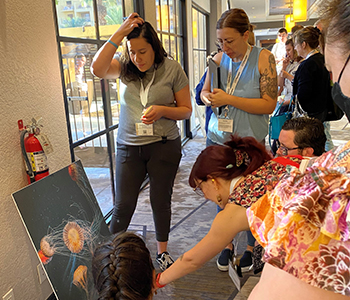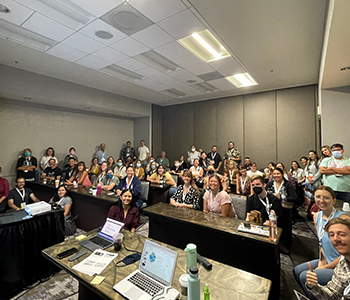Using Art to Communicate About The Importance Of The Ocean To Help Inspire Action
By Gabby Camacho, Jennifer Cao, and Kelley Le
Our ocean doesn’t get the attention that it deserves for such an important role that it plays in our lives. Many people are not aware that every second breath we take comes from the ocean. While the vast ocean is vital to all life on Earth, it is left largely unexplored.
The UCI Science Project recognizes the need to teach the importance of the ocean as one way to fight climate change. This aspiration led to starting a collaboration with The Ocean Agency and Adobe. The toolkit provides key facts, imagery, and other tools needed to create awareness and inspire action for students in elementary and secondary grades. The toolkit presents 7 things everyone should know about the ocean, inspired from the 7 Ocean Literacy Principles.
Our workshop titled, “Teach the Importance of the Ocean to Fight Climate Change,” was an introduction to the interconnectedness between the ocean and humans. To engage the teachers in this idea, we launched our session with a striking image of a scuba diver next to what looked like an underwater tornado at first glance, but looking more closely at it, you could see it was actually a large shoal of fish. It was in fact a real image, and we asked participants to think of the following questions: “What comes to mind? How does this image make you feel?”

It makes me feel small.
I want to be that scuba diver!
It is a bit frightening, but still amazing.
The room filled with more thoughts and exclaims. The educators will be immersed in a learning experience that uses multiple interpretations of pieces of art to learn about the importance of the ocean. It was key to first establish that connection to the ocean through visual imagery.
We revealed the seven posters that the participants would spend the next thirty minutes exploring. The teachers split up into small groups. We conducted a “Round Robin” in which teachers spent three minutes going over a list of guided questions, to generate discussion centered around the artwork they were observing. The questions were:
- How did the artwork make you feel or what did it make you think about?
- Does this artwork make you wonder about anything?
- How does the artwork represent how humans and the ocean are connected?

These questions sparked participants to discuss their initial wonderings and interpretations in order to dive deeper and reflect on how the artwork represented the connection between the ocean and humans. After the teachers had the initial discussion, they wrote their thoughts on a sticky note. After three minutes, each group rotated to the next piece of artwork and repeated the same process. The conversations among teachers were so rich and filled with personal experiences, and cultural interpretations of each artwork that spoke to the importance of the ocean and humans. We know that students learn best when they are able to access their funds of knowledge through authentic learning experiences.
When each group had a chance to visit all pieces of artwork, they returned to the first piece of art they started with, read others notes, identified if there were any patterns in other group’s comments, and discussed anything that resonated with them. Each group appointed a spokesperson shared their final thoughts. It was enlightening to hear such a variety of opinions and this part of the lesson highlights the importance of cyclical and iterative thinking.

We announced that each piece of artwork was commissioned specifically by an artist to represent a specific Ocean Literacy Principles, in which we ended the session by providing a brief overview of each principle. This lesson is one of many accessible and ready to use lesson plans for elementary and secondary educators to use. We included editable presentations in order for educators to meet the needs of their students.
Also, there are additional resources to continue teaching about the importance of the ocean, which include the next 3 toolkit lessons about the importance of coral reefs, mangroves, and seagrass ecosystems in mitigating climate change, supporting biodiversity, and taking action to fight climate change. These resources can be used as part of a larger unit or as smaller, investigative lesson plans in your class.
If you’ve enjoyed our workshop and resources, we will be recruiting teachers to pilot units on ocean acidification during the Spring of 2023 through our NOAA grant.
Resources:
- (This lesson) Teach the Importance of the Ocean to Fight Climate
- UCI Science Project Website
- UCI Science Project and The Ocean Agency Collaboration

Gabby Camacho, Associate Director of UCI Science Project

Jennifer Cao, Associate Director of UCI Science Project

Kelley Le, DIrector UCI Science Project and Executive Director of ECCLPs





